Ever wondered why your business keeps getting hit with cybersecurity “recommendations” that sound more like threats?
Here’s the deal: the cybersecurity world isn’t just evolving—it’s exploding. New vulnerabilities are discovered daily, attacks are growing more targeted, and digital risk is now a full-time business threat. And if you’re operating in India, CERT-IN compliance (CERT-IN full form: Computer Emergency Response Team–India) isn’t just another checkbox.
Cybercrime is projected to cost the world a staggering USD 10.5 trillion annually by 2025, up from USD 3 trillion in 2015. That’s not a small bump—it’s more than tripled in just a decade. Every industry is feeling the heat.
India isn’t watching from the sidelines. In 2023, we ranked third globally in number of cyberattacks. CERT-IN recorded over 1.16 million cybersecurity incidents in a single year, spanning phishing, ransomware, DDoS attacks, and data breaches. Banking, healthcare, and government sectors were among the hardest hit.
Still think compliance is optional? Think again. In today’s threat landscape, CERT-IN certification isn’t just about checking a box—it’s a survival strategy, and for many, a business imperative.
Why CERT-IN Compliance is Critical for Cybersecurity in 2025
The stakes aren’t just high—they’re brutal:
-
Regulatory Mandate: The Information Technology Act requires strict adherence to CERT-IN standards, especially for critical infrastructure sectors.
-
Severe Penalties: Non-compliance can result in up to one year of imprisonment and significant fines.
-
Tight Reporting Windows: CERT-IN mandates that incidents be reported within six hours—a timeline that leaves no room for delay.
India is also leveling up fast. With a 98.49/100 score in the Global Cybersecurity Index 2024, the country has joined the elite Tier 1 list of cybersecurity role models. That means enforcement is only getting sharper—and expectations higher.
But compliance isn’t just about staying out of jail. CERT-IN-certified organizations gain access to threat intelligence, response support, and priority advisories—real tools to defend against today’s sophisticated attacks.
In 2025, compliance equals resilience. And resilience equals trust. If your organization wants to compete in India’s digital economy, CERT-IN isn’t optional—it’s your competitive edge.
CERT-IN Certification Process—Step-by-Step
Getting CERT-IN certified might feel like a heavy lift, but when broken down into clear stages, the process becomes a lot more manageable. Here's how it typically unfolds:
- Choose the Right CERT-IN Empanelled Vendor
- Conduct Initial VAPT Audit
- Remediate Vulnerabilities
- Re-Test and Validate Fixes
- Get CERT-IN Certification
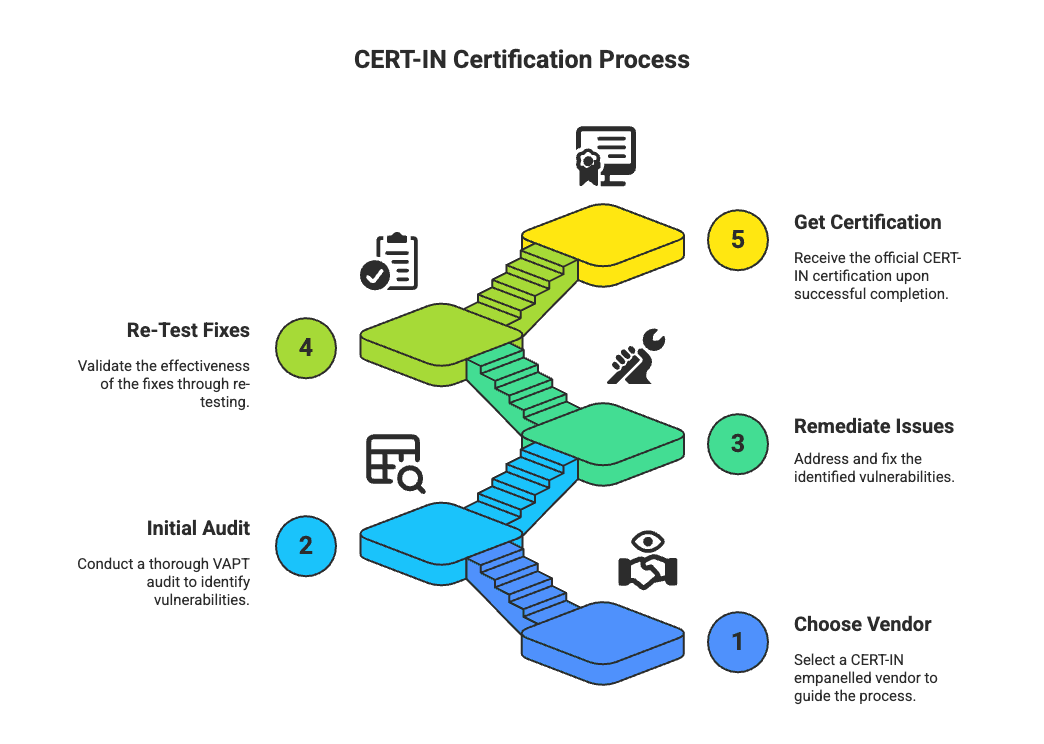
Certin Certification Process
Each step plays a critical role in proving your systems are secure, compliant, and ready for anything the threat landscape throws your way—so let’s dive into each one and see what it really takes to get certified.
1. Choose the Right CERT-IN Empanelled Vendor
Start by selecting an authorized audit firm from CERT-IN’s official list. Don’t just go with the lowest quote—look for:
- Deep experience across sectors (public and private)
- Strong team credentials (CISSP, CISA, ISO27001)
- A proven record of handling high-stakes projects (₹5 Cr+ audits)
Set clear expectations on timelines, scope, communication, and deliverables before kickoff.
2. Conduct Initial VAPT Audit
Once the vendor is onboard, it’s time for Vulnerability Assessment and Penetration Testing (VAPT). This Level 1 audit targets your web apps, infrastructure, and APIs using real-world attack simulations.
Deliverables include:
- A detailed vulnerability report
- Severity ratings and potential impact
- Technical + non-technical remediation advice
3. Remediate Vulnerabilities
Based on the audit report, your internal teams roll up their sleeves and start fixing:
- Patch high-severity issues first
- Update insecure configurations
- Implement missing security controls
Document all changes—you’ll need proof for the next round.
4. Re-Test and Validate Fixes
Once remediation is done, the vendor returns for Level 2 testing. This re-test checks:
- Whether vulnerabilities are fully resolved
- If new risks have emerged post-fix
- Whether the system now meets CERT-IN benchmarks
5. Get CERT-IN Certification
Pass the re-test, and you’ll receive the “Safe to Host” certificate—your formal declaration of cybersecurity compliance.
Just one caveat: the certificate is valid for one year. After that, it’s back to Step 1. But once you’ve done it right, recertification becomes faster, smoother, and way less stressful.
Who Needs CERT-IN Certification and Why It's Mandatory
Think CERT-IN certification is optional? Think again. Several categories of organizations in India have no choice—it's mandatory. And if you're wondering whether your business falls under these categories, you better figure it out fast.
RBI-Regulated Financial Institutions
Banks and financial institutions don't get to play around with cybersecurity. The rules are clear:
- All scheduled commercial banks must undergo annual CERT-IN empanelled security audits
- Payment system operators need certification before launching new products
- NBFCs handling customer data must maintain CERT-IN compliance
- Digital lending platforms must verify security posture through CERT-IN audits
The cost of ignoring these rules? RBI slapped penalties totaling ₹32.2 crores on banks for non-compliance with cybersecurity directives in 2023 alone. Ouch.
Government and NIC-Hosted Portals
Government digital infrastructure has zero tolerance for security gaps:
- All central government websites must obtain security clearance from CERT-IN empanelled auditors
- State government portals need certification before public deployment
- National Informatics Center (NIC) mandates CERT-IN security audits for all hosted applications
- E-governance initiatives require certification as per the National Cyber Security Policy
SEBI, UIDAI, and IRDAI Regulated Entities
Handle sensitive financial and identity data? You're on the hook:
- Stock brokers and trading platforms must maintain current CERT-IN certification
- Mutual fund operators need regular security validation
- Insurance companies processing policyholder data require compliance
- Entities accessing UIDAI services must demonstrate security readiness through CERT-IN certification
Critical Infrastructure Providers
Essential service providers can't afford to be the weak link:
- Power and energy distribution networks
- Telecom service providers and internet backbone operators
- Healthcare information systems storing patient data
- Water management systems and transportation networks
Critical infrastructure organizations now face mandatory incident reporting within 6 hours to CERT-IN. That's not a suggestion—it's the law. And it makes certification essential, not just recommended.
Here's the kicker: Any organization experiencing a cybersecurity incident must report to CERT-IN regardless of sector. Which means even if you're not in the mandatory categories today, you could be tomorrow. Better to be prepared than sorry.
#nothingtohide—except maybe from cyber criminals.
Top Benefits of CERT-IN Certification for Businesses
You’ve seen the scary stats. You know the mandatory requirements. But here’s what nobody talks about—the actual wins you get from CERT-IN certification.
This isn’t just about avoiding penalties. It’s about building a business that customers trust, partners respect, and competitors envy.
Demonstrates Compliance with IT Act 2000
CERT-IN certification proves your business aligns with the IT Act and related regulations.
- No more worrying about legal penalties or documentation gaps
- You get formal recognition of your security posture
- Critical-sector mandates? You're already covered
Boosts Customer and Partner Confidence
Trust is the new currency—and certification earns it.
- That badge tells clients you take security seriously
- Certified orgs see higher loyalty and confidence
- Stakeholders stop doubting and start depending on you
Reduces Risk of Data Breaches and Penalties
Certification is a proactive defense strategy.
- Comprehensive audits reveal bugs, misconfigs, and auth issues
- Cross-site scripting, zero-days? Found and fixed
- Breach risks and regulatory fines drop significantly
Improves Internal Security Controls
The process forces real change inside your org.
- Empanelled auditors bring outside expertise
- You build a culture of security-first thinking
- Regular testing keeps your defenses sharp
Bottom line: CERT-IN certification transforms your business into a breach-resistant, trust-building machine. And that’s a competitive edge you can’t afford to ignore.
Where to Find the CERT-IN Empanelled List
The official CERT-IN empanelled list is published by the Government of India on the CERT-IN website. It features all authorized cybersecurity audit firms eligible to perform CERT-IN-compliant assessments.
Each listing includes vendor details and empanelment validity, with updates made regularly. Before shortlisting, always verify that the vendor’s status is active and up to date.
But remember: being on the list doesn’t guarantee quality. Some vendors specialize in BFSI or cloud security, while others are better suited for government or legacy systems.
Tip: Use the list as your starting point—then vet vendors based on experience, certifications, and industry fit.
Top 5 CERT-IN Empanelled Vendors
CERT-IN empanelment is just the starting point. The real question is—which vendor actually knows how to secure your business?
With dozens of authorized players on the CERT-IN list, choosing the right one can make or break your compliance journey. Some vendors are built for formality. Others are built for real-world threats. Here are five industry leaders businesses across India trust—not just to check boxes, but to build resilience where it matters.
1. Uproot Security
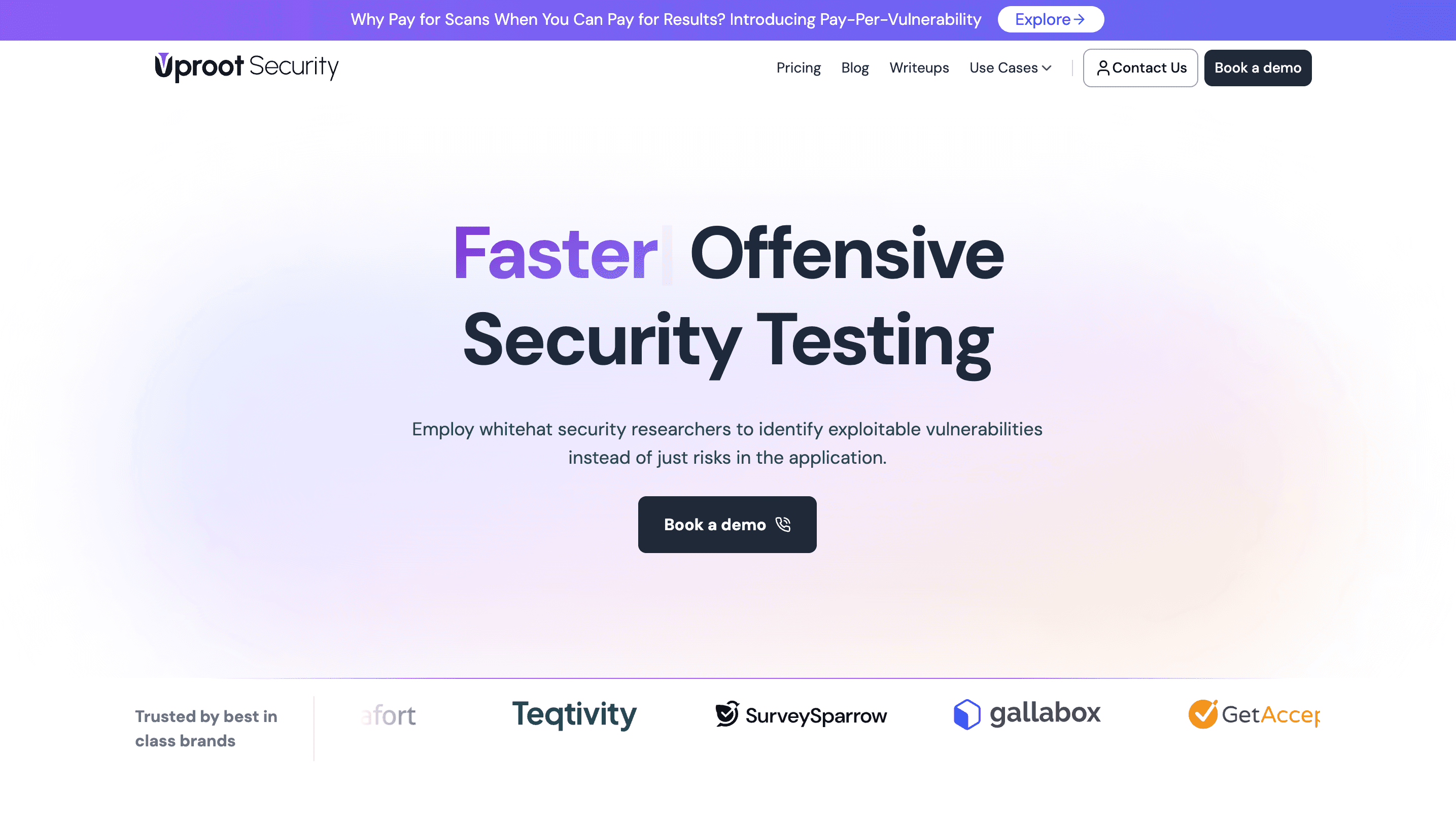
Uproot Security
Uproot Security is an emerging leader in enterprise-grade cybersecurity, known for its sharp technical expertise and hands-on audit execution. With a team of CREST-certified professionals and real-world offensive security experience, Uproot specializes in high-stakes CERT-IN audits across fintech, SaaS, and critical infrastructure. What sets them apart? Blazing-fast turnaround, deeply actionable reporting, and white-glove remediation support. If you're looking for a partner who doesn’t just scan, but helps you fix, Uproot brings clarity, speed, and confidence to your compliance journey.
2. Network Intelligence India (NII Consulting)
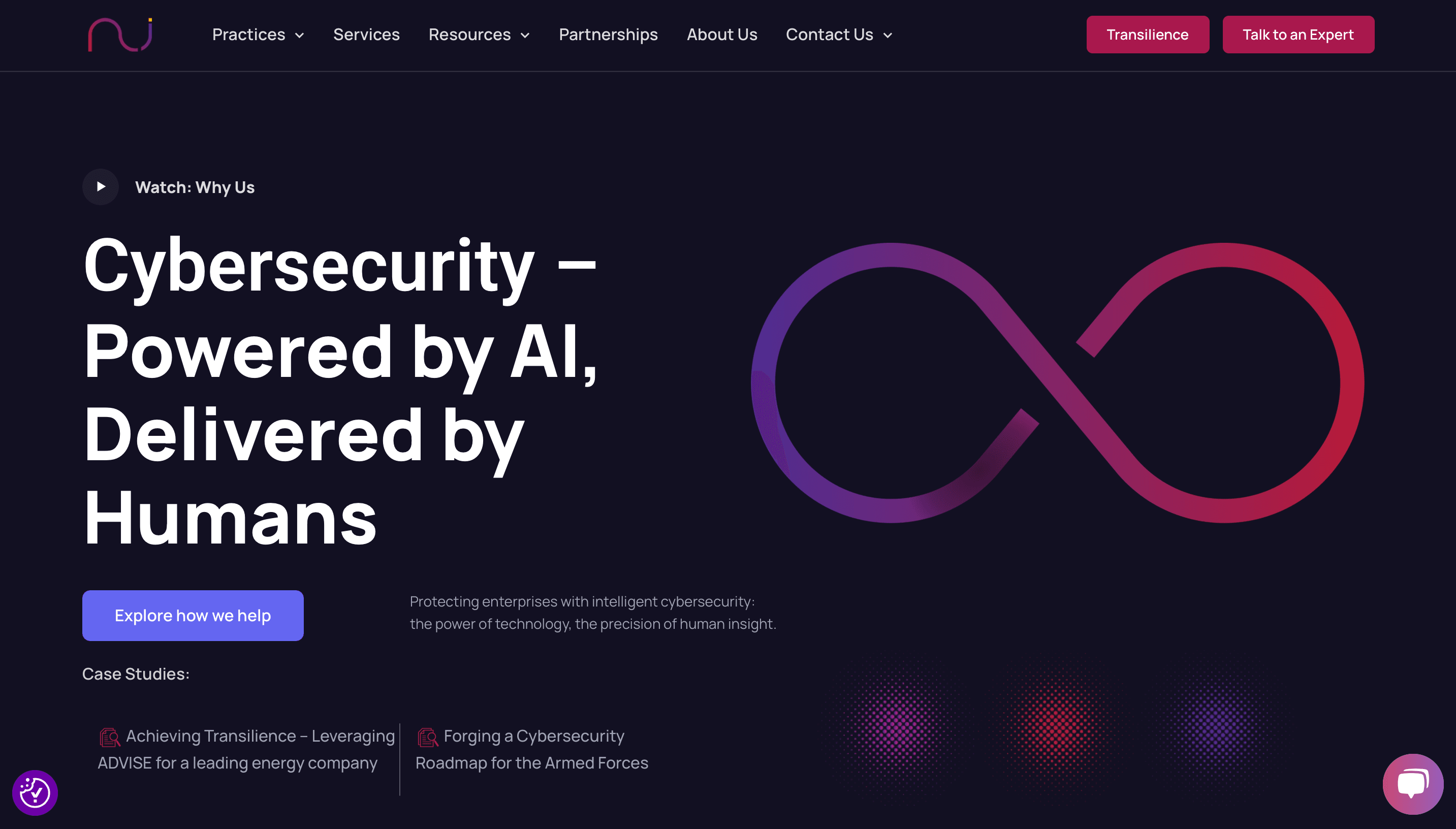
NII
One of the most respected names in Indian cybersecurity, NII has conducted over 1,000 CERT-IN audits across sectors. Their clients include banks, telecom operators, and government PSUs. What sets them apart is their ability to balance deep technical insights with real-world remediation support. If you're dealing with critical infrastructure or handling sensitive customer data, NII brings the muscle and clarity you need.
3. SISA Information Security
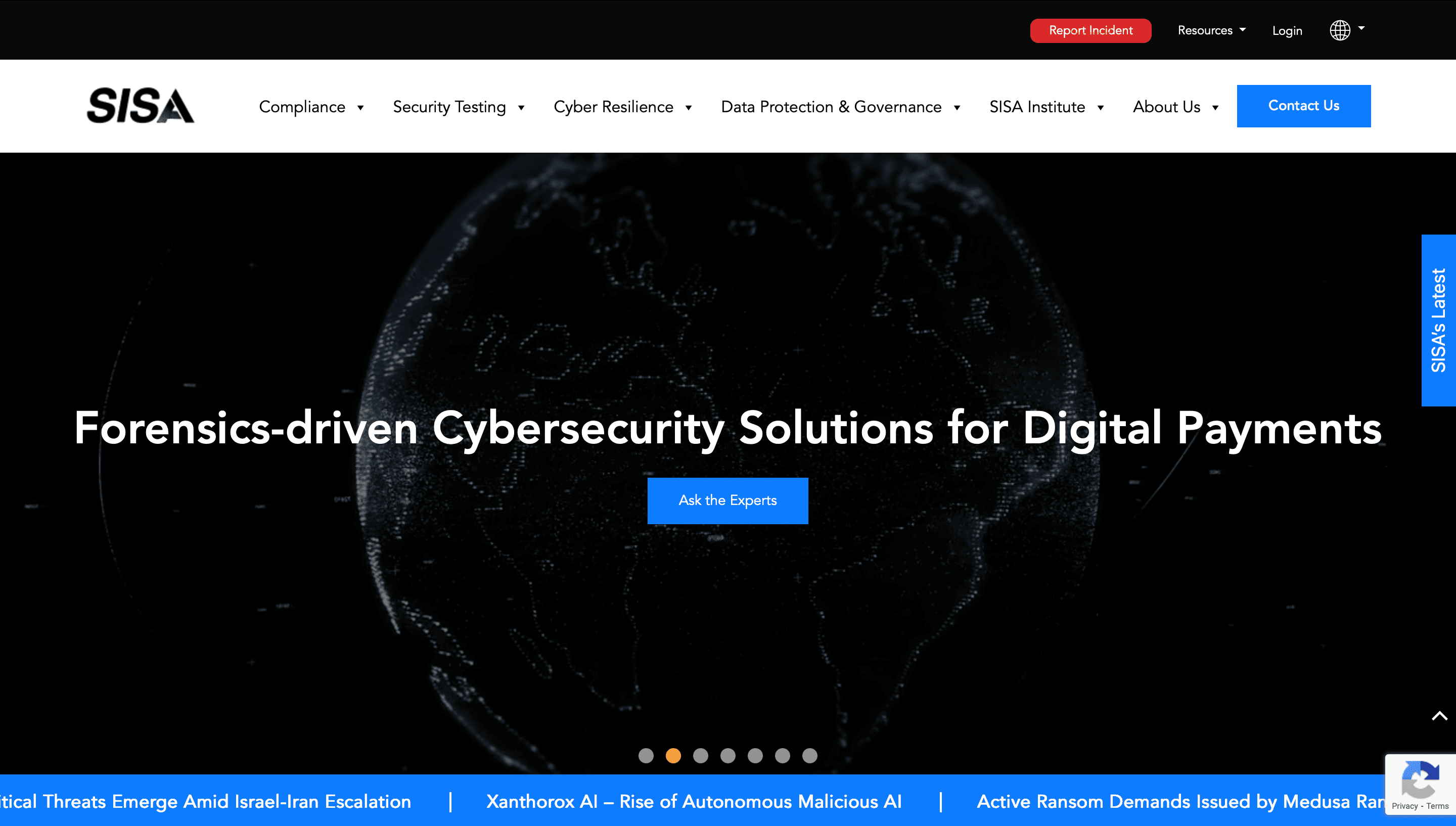
SISA
SISA has made its name in the fintech, payments, and BFSI sectors, where compliance is non-negotiable. Their strength lies in aligning CERT-IN audits with frameworks like PCI DSS, ISO 27001, and RBI cybersecurity directives. They also offer forensics and fraud analytics—making them a strong pick for risk-heavy industries looking for holistic security.
4. Tata Communications (TCIPL)
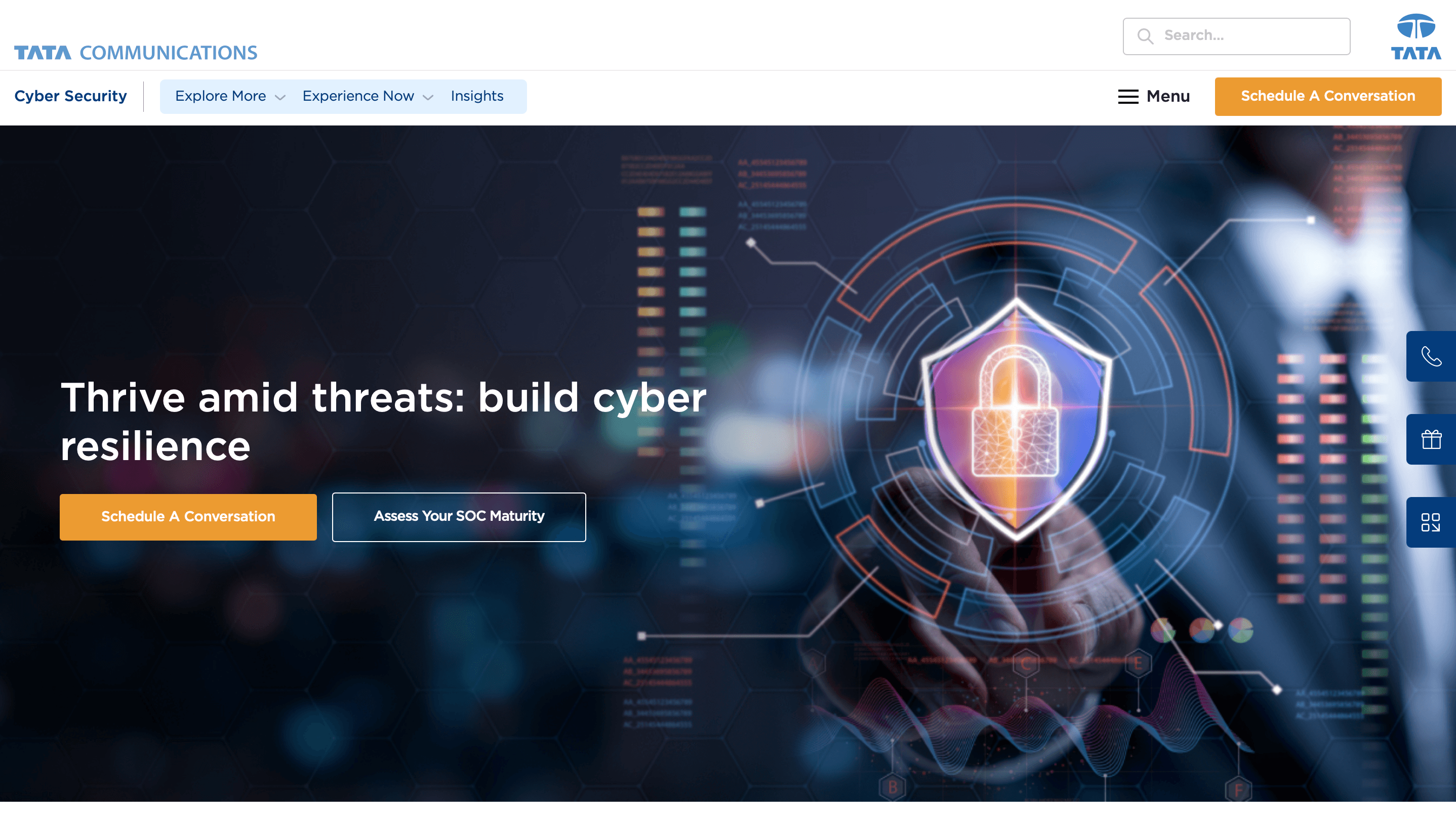
TCIPL
When scale and structure are non-negotiable, TCIPL delivers. Backed by the Tata brand, their security division handles complex multi-layered audits for both private enterprises and government infrastructure. Their approach is process-driven, documentation-heavy, and ideal for organizations that need bulletproof audit trails and board-level visibility.
5. Deloitte India

Deloitte
As a Big Four firm, Deloitte brings global cybersecurity standards to Indian compliance. They’re ideal for enterprises undergoing digital transformation or managing cloud-native environments. Their CERT-IN audit often feeds into broader security advisory work, making them a strategic partner for long-term growth.
Don’t treat this list as one-size-fits-all. The best vendor for your business will depend on your industry, systems, risk appetite, and internal maturity. Use this list as a launchpad—not a shortcut.
How to Choose the Right CERT-IN Empanelled Vendor
Picking the right CERT-IN empanelled vendor is like choosing a surgeon. You don’t go for the cheapest option when your business’s security is on the line.
Yes, the Indian government provides a list of authorized auditors. But not all vendors are created equal. Your choice will directly impact the strength of your security posture—and how painful (or smooth) the process is.
1. Prioritize Relevant Industry Experience
Look for vendors with a strong track record in your sector. Whether you're in BFSI, healthcare, or government, domain expertise matters. It means they understand your specific compliance requirements, threat landscape, and operational constraints.
How to check:
- Review client portfolios and case studies
- Look for event participation or industry-recognized talks
- Ask for peer recommendations
2. Evaluate VAPT Methodology and Tools
Structured audits produce better results. Ask how they conduct VAPT, what standards they follow (e.g., OWASP, NIST), and which tools they use. They should be able to test apps, APIs, cloud infra, and internal systems—clearly and confidently.
3. Review Their Reporting and Remediation Support
Top-tier vendors deliver reports that are:
- Risk-prioritized
- Free from fluff and jargon
- Paired with hands-on remediation guidance
Bonus points if they support you through patching and re-testing.
4. Verify Auditor Certifications
Your auditor’s credentials reflect their skill. Look for:
- CEH, OSCP for hands-on penetration testing
- CISSP for broad security expertise
- ISO 27001 Lead Auditor for compliance alignment
Bottom line: Don't choose based on price alone. The right vendor isn’t just a checkbox—they’re your frontline defense. Choose wisely. Your digital future depends on it.
Conclusion: Making CERT-IN Compliance a Business Priority
Let’s cut through the noise.
CERT-IN compliance isn’t just another government requirement. It’s your digital insurance policy in a world where 79 million cyberattacks hit India in 2023 alone.
The smart players? They’re already on it. CERT-IN-certified organizations aren’t just ticking boxes—they’re building trust, uncovering vulnerabilities before attackers do, and sleeping better at night. Their customers stay loyal. Their partners feel secure. Their bottom line improves.
If you’re in banking, government, or managing critical infrastructure, compliance isn’t optional—it’s survival. The penalties are real. The risks are brutal.
But here’s the catch: the right CERT-IN empanelled vendor makes all the difference. It’s not about the cheapest bid—it’s about smart expertise. Their process becomes your protection. Their credentials, your credibility.
We’ve covered it all—from why CERT-IN matters to how to get certified and who to trust along the way. The benefits are clear. The consequences of delay? Even clearer.
So ask yourself: Will you be the business that stays ahead—or the one that gets blindsided?
The choice is yours. And the clock is ticking.
Take control of compliance, reduce risk, and build trust with UprootSecurity — where GRC becomes the bridge between checklists and real breach prevention. → Book a demo today
Frequently Asked Questions

Robin Joseph
Senior Security Consultant
![CERT-IN Compliance Made Easy: Essential Steps for Businesses [2025] featured image](/_next/image?url=https%3A%2F%2Fs3.us-east-1.amazonaws.com%2Fstatic-production.uprootsecurity.com%2Fwebsite%2Fstrapi-content%2Fuploads%2FCert_in_eea2e6e117.jpg&w=3840&q=75)